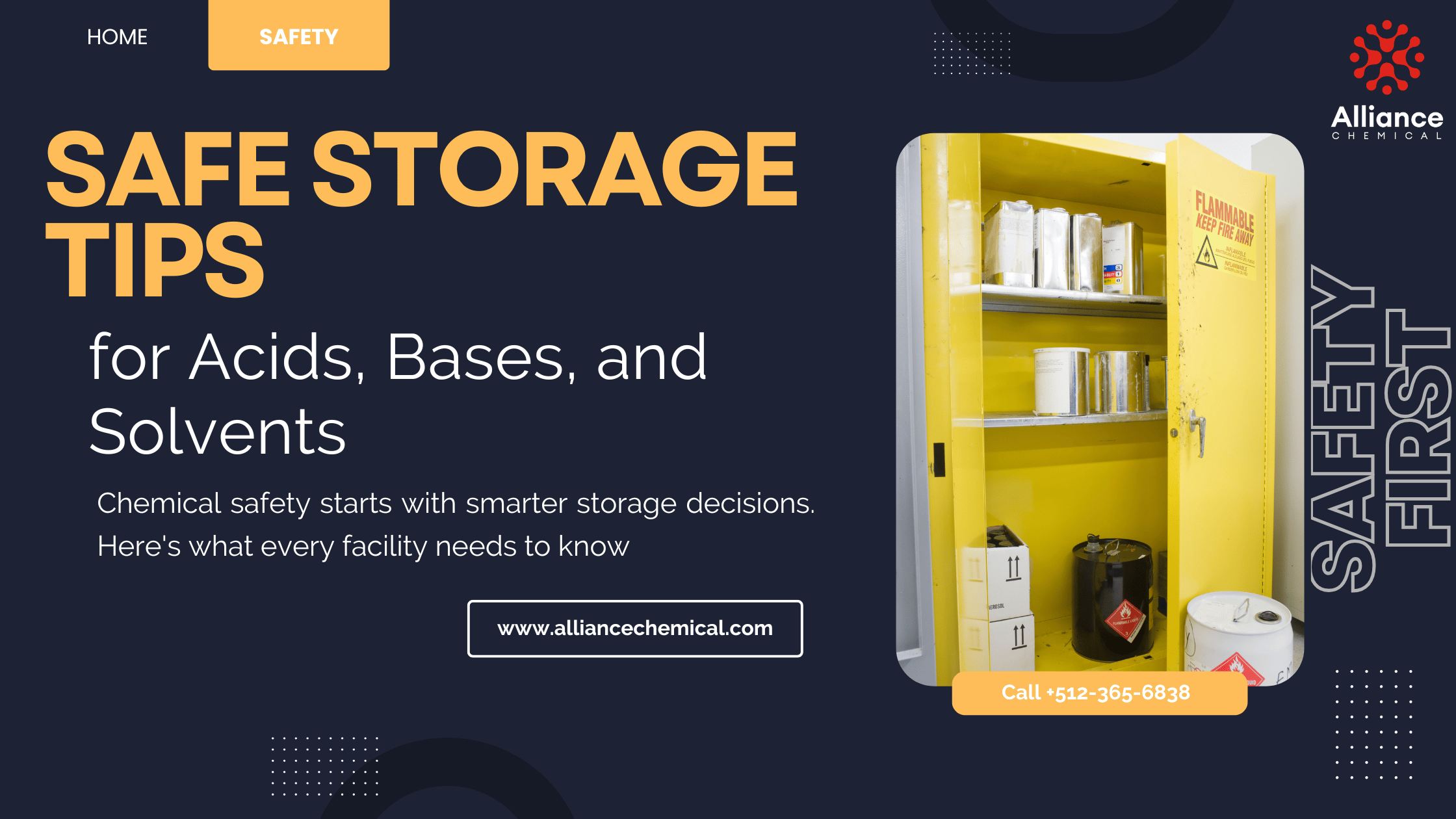
Safe Storage Tips for Acids, Bases, and Solvents: What You Must Know
Table of Contents
Summary
📋 What You'll Learn
This guide will walk you through safe storage tips for acids, bases, and solvents: what you must know with detailed instructions.
Unlock the secrets to safely storing common laboratory and industrial chemicals. Learn best practices to prevent accidents, ensure compliance, and maintain chemical integrity.
Introduction: Why Chemical Storage Safety Matters
Acids, bases, and solvents are fundamental building blocks in countless industrial processes, research labs, and even specialized workshops. While incredibly useful, these chemicals possess inherent hazards. Improper storage can lead to dangerous reactions, toxic fumes, spills, fires, injuries, and costly environmental damage. Understanding and implementing safe storage practices isn't just about ticking compliance boxes (like OSHA's Hazard Communication Standard) – it's about protecting personnel, preserving property, and ensuring the integrity of your valuable chemical inventory.
This guide provides essential tips for safely storing three common chemical categories:
- Acids: Corrosive substances that can damage materials and living tissue.
- Bases (Alkalis/Caustics): Often corrosive or caustic, reacting strongly with acids.
- Solvents: Liquids used to dissolve other substances, frequently flammable or volatile.
Let's dive into the core principles and specific considerations for each type.
Universal Principles for Safe Chemical Storage
Regardless of the specific chemical, some fundamental safety rules always apply. Establishing these baseline practices creates a safer environment for everyone.
Ventilation is Key
Store chemicals in well-ventilated areas to prevent the buildup of hazardous vapors. Use fume hoods for volatile substances where appropriate.
Clear Labeling
Ensure all containers are clearly labeled with the chemical name, concentration, hazard warnings (GHS symbols), and date received/opened. Never use unlabeled containers.
Inventory Management
Maintain an accurate, up-to-date inventory list. Know what you have, where it is, and its quantity. Use a "first-in, first-out" system.
Designated Storage Areas
Store chemicals in designated areas away from high traffic zones, heat sources, direct sunlight, and emergency exits. Avoid storing chemicals on floors.
Regular Inspections
Periodically inspect storage areas and containers for leaks, damage, expired chemicals, or deteriorating labels. Address issues promptly.
Appropriate PPE Access
Ensure Personal Protective Equipment (gloves, goggles, lab coats) suitable for the stored chemicals is readily available near the storage area.
Storing Acids Safely: Handling the Corrosive Challenge
Acids demand respect due to their corrosive nature and potential reactivity. Proper storage minimizes risks associated with spills, fumes, and unwanted reactions.
Key Considerations for Acid Storage:
- Corrosivity: Store acids in corrosion-resistant cabinets or trays designed for acids. Polyethylene or specialized coated steel are common choices. Avoid storing acids above eye level.
- Fume Control: Many acids release corrosive fumes. Ensure adequate ventilation or store in ventilated acid cabinets, especially strong acids like Hydrochloric Acid or Nitric Acid.
- Segregation is Crucial: Store acids separately from bases, active metals (like sodium, potassium), cyanides, sulfides, and organic solvents. Pay special attention to separating oxidizing acids (like Nitric Acid, concentrated Sulfuric Acid [SDS for 93%]) from flammable or organic materials.
- Suitable Containers: Use original containers when possible. If transferring, use compatible materials like glass or specific plastics (HDPE, PP, PTFE) suitable for the specific acid and concentration. Check compatibility charts!
- Spill Containment: Use secondary containment trays or bins capable of holding the volume of the largest container to catch potential leaks or spills.
Alliance Chemical: Your Source for Quality Acids
Whether your application requires robust mineral acids like Sulfuric, Hydrochloric, or Phosphoric Acid (SDS for 85%), or specific organic acids like Acetic Acid, Alliance Chemical provides a wide range. Remember, safe handling starts with quality products and proper storage. Check out our full Acid collection.
Storing Bases Safely: Managing Caustics and Reactivity
Bases, also known as alkalis or caustics, present their own set of storage challenges, primarily related to their corrosive nature and strong reactivity with acids.
Key Considerations for Base Storage:
- Caustic Nature: Like acids, many bases are corrosive to skin, eyes, and materials. Store them in designated areas, preferably in dedicated base cabinets.
- Reactivity with Acids: Never store bases near acids! Accidental mixing can cause violent exothermic reactions, releasing significant heat and potentially splattering hazardous material.
- Segregation from Others: Keep bases away from certain metals (like aluminum, zinc, magnesium, especially in solution), organic compounds, and oxidizing agents unless compatibility is confirmed.
- Container Integrity: Use appropriate containers resistant to bases. Glass can be etched by strong bases over time; high-density polyethylene (HDPE) is often suitable. Ensure lids are tightly sealed. Powerful Sodium Hydroxide (like flakes or 50% solution [SDS for 50%]) can be hygroscopic and needs airtight containers.
- Spill Control: Utilize secondary containment to manage potential spills. Have appropriate neutralizers (like weak acids, *used cautiously*) available in spill kits designed for bases.
Find the Right Base at Alliance Chemical
From versatile hydroxides like Sodium Hydroxide (Lye) and Potassium Hydroxide, to Ammonia solutions and various carbonates like Soda Ash, Alliance Chemical supplies a comprehensive range of bases and caustics. Ensure you have the right grade and quantity, stored safely, for your needs.
Storing Solvents Safely: Taming Flammability and Volatility
Solvents are perhaps the most common category with significant storage risks, primarily due to flammability and vapor hazards.
Key Considerations for Solvent Storage:
- Flammability: This is the paramount concern for most organic solvents (e.g., Acetone, Isopropyl Alcohol, Toluene, Hexane). Store flammable solvents in approved flammable storage cabinets, away from ignition sources (sparks, flames, hot surfaces). Know the flashpoint!
- Volatility & Vapor Control: Solvents evaporate easily, creating potentially flammable or toxic atmospheres. Ensure excellent ventilation in storage areas. Keep containers tightly sealed when not in use.
- Toxicity: Many solvents pose health risks through inhalation or skin contact. Understand the specific hazards (refer to Safety Data Sheets - SDS) and store accordingly.
- Grounding and Bonding: When transferring large quantities of flammable solvents, ground containers and equipment to prevent static electricity buildup, which can ignite vapors.
- Segregation: Keep solvents separate from oxidizing agents (like hydrogen peroxide, nitric acid, permanganates) and other incompatible materials.
Fire Safety First with Solvents!
Always prioritize fire prevention when storing solvents. Use designated flammable storage cabinets, ensure no ignition sources are nearby, and maintain good ventilation. Alliance Chemical offers a wide variety of solvents, including alcohols, ketones (like MEK [SDS]), esters, hydrocarbons, glycols, and specialized chlorinated or citrus solvents. Choose wisely and store safely!
Segregation: The Golden Rule of Chemical Storage
One of the most critical aspects of safe storage is keeping incompatible chemicals physically separated. Mixing incompatible substances can lead to fires, explosions, or the release of toxic gases. Use distance or physical barriers (like separate cabinets or rooms) for segregation.
Think Before You Store!
Always consult the Safety Data Sheet (SDS) for specific incompatibility information. When in doubt, separate!
Common Incompatible Chemical Groups (Never Store Together):
| Chemical Group 1 | Chemical Group 2 (Incompatible With) | Potential Hazard |
|---|---|---|
| Acids | Bases (Caustics, Alkalis) | Strong heat generation, splattering |
| Acids | Cyanides, Sulfides | Release of highly toxic gases (HCN, H2S) |
|
Oxidizing Agents (e.g., Nitrates, Peroxides, Permanganates, Chlorates, Nitric Acid, Hydrogen Peroxide, Sodium Hypochlorite) |
Flammable/Combustible Materials (Solvents, Oils, Wood, Paper), Reducing Agents (Metals, Hydrides), Organic Compounds | Fire, explosion |
|
Flammable Solvents (e.g., Acetone, Ethanol, Hexane, Toluene) |
Oxidizing Agents | Fire, explosion |
|
Water-Reactive Chemicals (e.g., Sodium metal, Potassium metal, Calcium Carbide) |
Water, humidity, aqueous solutions | Fire, explosion, release of flammable gas |
|
Concentrated Bases (e.g., Sodium Hydroxide, Potassium Hydroxide) |
Certain Metals (Aluminum, Zinc), some Organic Halides | Gas generation, potential explosion |
Note: This table is not exhaustive. Always refer to the specific SDS for detailed incompatibility data.
Container Integrity and Clear Labeling
The container is your first line of defense against spills and exposure. Using the right container and ensuring it's properly labeled is fundamental to safe storage.
The Right Container Matters
- Material Compatibility: Ensure the container material is chemically resistant to the substance stored inside. Avoid storing corrosives in metal cans unless specifically designed and lined. Check compatibility charts for plastics (HDPE, LDPE, PP, PVC, PTFE etc.).
- Condition: Regularly inspect containers for cracks, leaks, rust, or signs of degradation. Replace damaged containers immediately, transferring contents to a suitable, clean, and properly labeled new container.
- Seals and Closures: Ensure caps and lids fit properly and seal tightly to prevent leaks and vapor escape. Replace worn or damaged seals.
- Secondary Containment: Use spill trays or larger containment bins, especially for liquids, to catch potential leaks from the primary container. Choose secondary containment materials compatible with the stored chemical. Alliance Chemical offers various containers and equipment suitable for chemical storage needs.
Clear and Accurate Labeling
- Essential Information: Labels must clearly identify the contents (full chemical name, not abbreviations), concentration (if applicable), primary hazards (using GHS pictograms and signal words), date received, and date opened.
- Durability: Use labels resistant to the chemical being stored and the storage environment (e.g., waterproof, chemical-resistant labels). Ensure handwriting is legible if not using printed labels.
- Standardization: Adhere to GHS (Globally Harmonized System) labeling standards for hazard communication.
- Relabeling: If transferring chemicals to a secondary container, that container MUST be labeled immediately with all necessary information. Never use unlabeled containers, even temporarily.
Emergency Preparedness: Planning for the Unexpected
Even with the best storage practices, accidents can happen. Being prepared to respond quickly and safely to spills or fires is crucial.
Spill Kits
Maintain well-stocked spill kits appropriate for the types of chemicals stored (e.g., acid neutralizers, base neutralizers, solvent absorbents). Ensure personnel know where they are and how to use them.
Eyewash & Safety Showers
Ensure functional, regularly tested eyewash stations and safety showers are easily accessible within seconds of chemical handling and storage areas.
Fire Safety Equipment
Have the correct type of fire extinguishers readily available (e.g., Class B for flammable liquids, Class ABC for general use). Ensure they are inspected regularly and personnel are trained in their use.
Emergency Plan & Contacts
Develop a clear emergency response plan. Post emergency contact numbers (fire department, poison control, internal safety officer) prominently near storage areas.
Regular Training
Train all personnel who handle or work near chemicals on safe storage procedures, hazard recognition, proper PPE use, and emergency response actions, including spill cleanup.
Safety Data Sheets (SDS)
Keep SDS readily accessible (digitally or physically) for every chemical stored. They contain vital information on hazards, handling, storage, and emergency measures. We've linked some examples in this article!
Conclusion: Safety is Non-Negotiable
Properly storing acids, bases, and solvents is a critical component of laboratory and industrial safety. By understanding the specific hazards of each chemical class, implementing universal storage principles, prioritizing segregation, using appropriate containers, maintaining clear labels, and preparing for emergencies, you create a significantly safer working environment.
Remember, safety isn't a one-time task; it requires ongoing vigilance, regular inspections, and continuous training. Investing time and resources into safe chemical storage protects your most valuable assets: your people, your facility, and the environment. Always consult the specific Safety Data Sheet (SDS) for the chemicals you are handling.
Need guidance on the right chemical or container for your application? Alliance Chemical is here to help.
Store Chemicals Safely with Alliance Chemical
From high-quality acids, bases, and solvents to appropriate containers and safety guidance, Alliance Chemical is your partner in safe chemical management. Contact us for expert advice or browse our extensive product lines.
Contact Us Today Shop All Products



